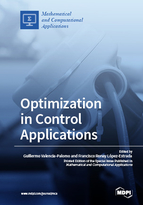Optimization in Control Applications
A special issue of Mathematical and Computational Applications (ISSN 2297-8747). This special issue belongs to the section "Engineering".
Deadline for manuscript submissions: closed (30 September 2018) | Viewed by 47316
Special Issue Editors
Interests: predictive control; optimization; LPV systems; fault detection and isolation
Special Issues, Collections and Topics in MDPI journals
Interests: control applications; optimization; LMIs; Takagi–Sugeno; fault diagnosis
Special Issues, Collections and Topics in MDPI journals
Special Issue Information
Dear Colleagues,
Mathematical optimization is the selection of the best element in a set with respect to a given criterion. Optimization has become one of the most used tools in modern control theory to compute the control law, adjusting the controller parameters (tuning), model fitting, finding suitable conditions in order to fulfill a given closed-loop property among others. In the simplest case, optimization consist in maximize or minimize a function by systematically choosing input values from a valid input set and computing the function value. Nevertheless, real-world control systems need to comply with several conditions and constraints that has to be taken into account in the problem formulation which represent challenges in the application of the optimization algorithms.
In this Special Issue call, the aim is to offer a state-of-the-art of the most advanced optimization techniques (online and offline) and its applications in control engineering. Potential topics include (but not limited to):
- Optimal control of nonlinear systems;
- Optimal control of complex systems;
- Predictive control;
- Optimal observer design;
- Principal component analysis;
- Neuronal networks;
- Numerical optimization;
- Evolutionary optimization;
- Constrained optimization;
- Control systems.
Prof. Dr. Guillermo Valencia-Palomo
Dr. Francisco Ronay López-Estrada
Guest Editors
Manuscript Submission Information
Manuscripts should be submitted online at www.mdpi.com by registering and logging in to this website. Once you are registered, click here to go to the submission form. Manuscripts can be submitted until the deadline. All submissions that pass pre-check are peer-reviewed. Accepted papers will be published continuously in the journal (as soon as accepted) and will be listed together on the special issue website. Research articles, review articles as well as short communications are invited. For planned papers, a title and short abstract (about 100 words) can be sent to the Editorial Office for announcement on this website.
Submitted manuscripts should not have been published previously, nor be under consideration for publication elsewhere (except conference proceedings papers). All manuscripts are thoroughly refereed through a single-blind peer-review process. A guide for authors and other relevant information for submission of manuscripts is available on the Instructions for Authors page. Mathematical and Computational Applications is an international peer-reviewed open access semimonthly journal published by MDPI.
Please visit the Instructions for Authors page before submitting a manuscript. The Article Processing Charge (APC) for publication in this open access journal is 1400 CHF (Swiss Francs). Submitted papers should be well formatted and use good English. Authors may use MDPI's English editing service prior to publication or during author revisions.
Keywords
- optimization
- optimal control
- optimal conditions







